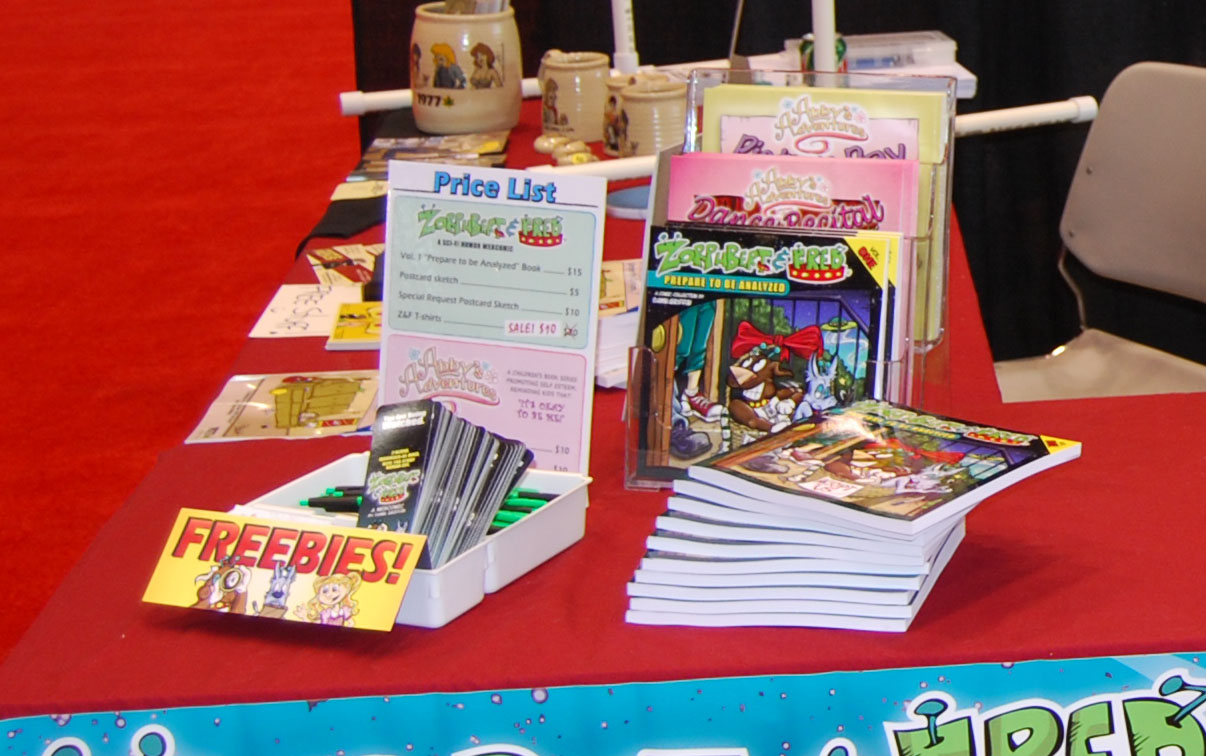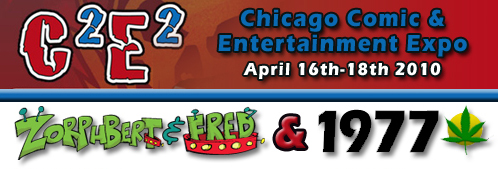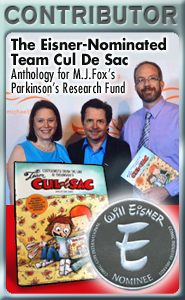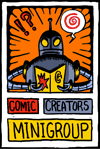On my flight back from Chicago’s C2E2 on Sunday evening, I was running through lists in my head of the things I did right, and what I did wrong. (I should have been jotting them down, so let’s hope my memory serves me well). I am very confident that my next comic con will be better, and less stressful. Even with all the help from Byron Wilkins of 1977 (picking me up from the airport, hauling in my stuff and setting up, tearing down), I am still not an experienced traveller and that element hindered my experience a bit. But all in, it went smoothly, and the next time around the traveling will hopefully be the lesser occupant of my thoughts.
There are terrific articles out there already about how to prepare for a convention. What to pack. How to determine your goals for the convention. Miscellaneous tips and guidelines. But an actual experience trumps all that for me. Every exhibitor has different goals, and a different audience, and therefor needs to prepare in different ways. Here’s some bullet points I have learned from my experience at C2E2:
• After you secure your plane tickets and hotel reservation, be sure to check your airline’s regulations. Especially for the arrival time, and the baggage weight and measurements. My airline suggested arriving an hour and a half before departure (which ended up being more than I needed, but still a good idea), and my baggage came in under the specified 50lbs…. or I would have had to pay a hefty fee.
• If you fear your supplies will weigh more than 50lbs (VERY likely, books are heavy!), ship your supplies out to a friend in the area, or directly to the convention center. I shipped 90% of what I needed to Byron, and he was sweet enough to bring it all in for me.
• Plan to bring all your supplies in at once. Some convention halls are very strict with this- they charge a fee for each unloading, and will insist they bring your supplies in themselves… so there’s no getting around it! If you cannot carry it in your arms, they will make you hand it over to them and pay a fee. Byron and I worked this out pretty well.

• For heaven’s sake, bring a TON of freebies. Whether they be pens, bookmarks, fliers, business cards… whatever you can afford. People LOVE freebies, especially bookmarks, they seemed to be the hot freebie at this convention. (Plus, for you comic strip people, a single strip fits SO dang nicely on the back of one!) I started to run out of freebies on FRIDAY (the slow day!), so I had to be stingy with giving them out the rest of the weekend, which sucked. Big time. My biggest mistake. When just starting out at comic cons, your first goal should be exposure, and you need to get your URL in their hands!
• People like to browse and buy at the end of the day. Many people said they were interested and would come back and buy a book if they could afford to. Some did. Keep this in mind. People may remember your work, and come back.. be prepared for a slow start, and hopefully a strong finish.
• The last point leads me to this one– Stay for the ENTIRE con. My Sunday flight left around the time the last day ended, so I had to leave right in the middle of the busiest time on Sunday. I had a sale pop up the second I was about the run out the door to catch my shuttle to airport. Probably would have had more sales if I had stayed.
• Smile. Make eye contact. Seriously. I know this sounds like a cheesy dating-service tip, but it encourages people to approach your booth. And that is key, if you get them to your booth, you have a good 85% chance they’ll take a freebie (and maybe become a fan). For me, I’d say 15% of people who approached the booth bought something, and even if they didn’t have the cash, a nice engaging conversation took place… which might make someone going through their freebies say, “oh, right, I remember her.” For you shy peeps out there (I’m not entirely super- outgoing either), you have to move past some insecurities.. both with chatting up new people, and with drawing in front of people. For me, a short stint with caricaturing at an Outback Steakhouse years ago cured me of that issue ;0)
• Nail down your mini-pitch and your full pitch. I’m only a newbie at this, but here was my strategy:
–If my banners made the person pause, I greeted them. Sometimes being greeted made people shy/anxious, and they scuttled off… oh well.
–If they stayed for an extra second or so, I gave them my mini pitch “2 aliens, disguised as dogs, here to study human life” while pointing to or showing them my book. I offered freebies here. I’d say half left after scoring a freebie.
–If they seemed interested or started flipping through the book, I went on to babble about influences (the TV show 3rd Rock From the Sun, most of us geeks liked that show), explain the strip as a “social commentary from a true 3rd person point of view, with a sci-fi twist.” Probably had a good 50 of these hangers-on.
–From here, this may have sparked small talk, hand shaking, name exchanges. Key time to make the sale. Let them know the prices (or sales you’re running!). If I did not make a sale here, I was pretty sure this person would check out my strip online. In total, I’d say I had maybe 25 of these types (not counting those who knew of me, or my work).
*note: I was also selling my “Abby’s Adventures” book, so that was tossed into my pitch if there was a child involved, or if the person could be a parent.
• Prepare yourself to also be the sell-ee. Trade booth graphics companies, book printers, promo printing companies go booth to booth, and will come chat you up, and you may not realize until 10 minutes in, that they are not interested in your comic at all, but in selling YOU something. Those 10 minutes could have been another new reader or a sale. Keep an eye on people’s badges, so you can avoid this if possible. Byron had a good idea in telling one salesman “Look, if you buy a book, I’ll let you tell me more about your product”. It’s always favorable to be nice, but you cannot be giving up sales because of these people. Unless, of course, what they’re selling really does interest you. For me, not so much.

• Perfect your table spread. I played around with my set-up. Byron and I shared a corner booth, but we had 2 separate tables, which helped give us some separation. My colorful banners attracted attention, as did Byron’s. I think my cut-outs of Z&F helped, but the big attraction was my FREEBIES! sign. Everyone on Friday saw that sign and wandered over. I would like to get a table cloth in a teal, or a star/space pattern, to better match my banners. Red was not a bad color either, however.
• Corner booths are GREAT. Gets the most attention. If you can pick your booth, shoot for a corner, towards the center of the room.

• Do not forget about KIDS! They are more and more present at cons. Sunday at C2E2 was “Kids day”, and kids got in free. They ran rampant. A freebie aimed towards kids is not a bad idea, especially if your comic is family friendly. I didn’t sell a ton, but got a lot of interest because both brands I was selling were family friendly. Byron’s comic is more adult, but he had whistles for kids just to earn a little bit of cash. Note: he did not put his URL on the kids’ stuff… you do not need angry parents emailing you when their kid goes online because of the item you sold them!
• Sketch! Postcards with a blank back make for great sketch cards you can sell for a smaller chunk of change. I brought my trusty iphone, to use for references from the internet. Most convention centers will charge you for a power outlet or wifi for your laptop, but AT&T 3G service worked dandy for me. I even did commissions. The hard part is remaining approachable while sketching, you cannot get “into the zone” too much or no one will feel welcome to drop by. The biggest seller: sketches of Snarf from the Thundercats. Who knew?
• Finally, do not forget to mingle and network with other creators. Nothing helps your traffic more than a popular webcomic creator who decides to write a blurb about you on their blog, or tweet a sentence about how much they dig your work. I tried to wander a bit (wish I had time to do it more), and watch how others pitched their comic … took mental notes, and tried some of their tactics myself. After all, if you’re serious about webcomics… these are your people! You will never feel more at home than amongst other cartoonists.









I also find product bundles work well, especially if they’re a bit “unadvertised.” If someone’s flipping through a mini and it’s a two-parter, I’ll tell them I’ll give them both for (price of both) – $1 or something. I’ve sold a lot of bundles that way.
Also, I found the benefit of having a remarkable gimmick. I have a friend (R. M. Rhodes) who wears multiple purple suits at every con he’s at. When he’s following up with people, he can just say, “I’m the guy in the purple suit.” The comparisons between this and Seth Godin’s idea of a “purple cow” were not lost on either of us, so that’s why I now get every person who walks by my table to give me words for my comic. Hopefully I can become “the word guy.”
Bundles are a terrific idea! I just need more books. ;0) But I should keep that in mind for the 2.. almost 3.. Abby books that we’re selling now. Thanks John!
A gimmick, hmm? I need to buy a pair of those goofy alien antennae headbands… it’s a start. Maybe a “Space Cadet” pin, and those I could market pretty easily too ;0)
OOooooohhhh.. gears a-turnin’!
Pins work *really* well, especially if they’re cute. At Heroes Con last year, my neighbor had a webcomic, no books, and little dragon pins, and I think she did way more business than she was expecting to. Though if you start wandering around Baltimore w/ the antenna headband, I will have to get one of the many Darth Vaders to attack you. 😛
Dawn, Great podcast with Tom!
Question: how big is that Z&F banner and how did you hang it? Was it pricey to print?
Thanks Lucas! I actually felt like I could have gone on for another hour during that interview, with all I took away from the Con. The Z&F banner is 6 feet tall. I used Vistaprint to print it, came out pretty well! Good quality, I think. But as usual with me, I want to fix up the design already. The banner itself was on sale for a decent price ($30 maybe?), and I also bought a banner stand for $40 from them too. However, in the pics I am using the PVC pipe banner stand Byron made from scratch. Cheap, and easy to ship! The banner stand is a bit harder to ship. Would love to get a retractable.. heard you can find ’em cheap on ebay!
Great tips! I’ll have to bookmark this and read it over before the next time I exhibit at a convention.
Wow, you’ve got your act together! Awesome tips, thank you.